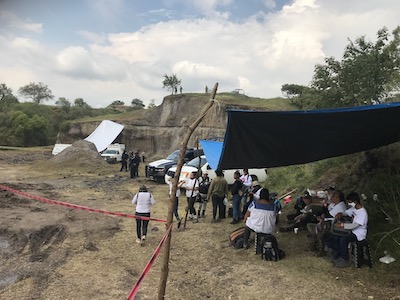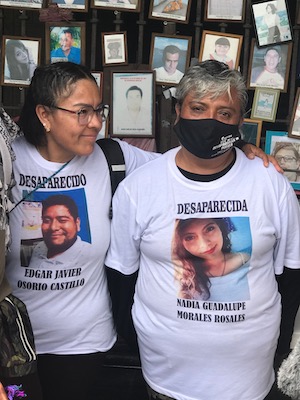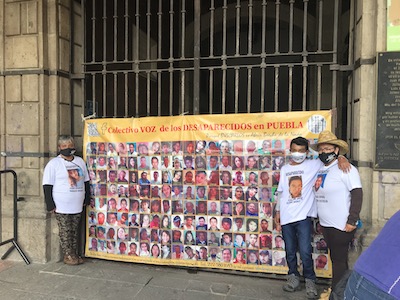 The motto of the VI National Search Brigade, the central project of the Enlaces Nacionales (National Links) Network, is “In searching for the disappeared, we find each other”.
The motto of the VI National Search Brigade, the central project of the Enlaces Nacionales (National Links) Network, is “In searching for the disappeared, we find each other”.
It makes sense on many levels. The brigades have unearthed hundreds of human remains and clues to the whereabouts of their loved ones, disappeared throughout Mexico. Their goal is to find them and return them to their families, and that in a context where the state and a large part of society have buried their very existence.
In the effort, the families have found each other, forging a larger family of thousands of the families directly affected by forced disappearance in the country. United by pain and perseverance, they bond in the collective effort of the search. In the act of organizing, they find the force that drives them to break through helplessness and despair, and rebuild broken communities, broken wills, and quenched hopes.
At the social level, the famllies find the voice and the strength to confront violence beyond its manifestations, addressing its causes. The coming together is multifaceted, diverse and inclusive. In addition to family members of the victims of violence that affects people of all classes, races, genders and states, individuals and groups in solidarity, including students, professionals, academics, scientists, journalists, feminists, and human rights activists, from Mexico and other countries, have joined the movement.
By focusing its mission on finding the disappeared and honoring their memory, the movement defends the value of human life, and creates a shared platform among all sectors, regions and diversities. The Sixth National Brigade for the Search for Disappeared Persons carried out its work in the state of Morelos between October 9 and 23. In 2021, Mexico was hit hard by the pandemic and the third wave that began in early June filled hospitals and generated more infections, although fewer deaths.
The brigade was scheduled to start on August 16, after months of planning. The relatives of the disappeared had to make the hard choice of suspending it for health reasons. While they waited for the conditions to go out and search again, violence and disappearances didn’t stop – they remained between 20 and 60 a day according to official records. The families say they are caught between two pandemics – COVID-19 and the pandemic of disappearances.
When the risks dropped in the state, the Brigade members finally came out initiated the search, this time with picks and shovels and face masks. They developed special protocols for the Search Brigade’s activities due to the health crisis, and they modified their work methods. In a world of multiple crises, work against insecurity has to be as safe as possible.
Since its inception in 2016, the Brigade has grown from seven groups to the 164 groups from 27 states of the republic that participated in the Morelos search. In the VI Brigade they found eleven clandestine graveyards, several human bone fragments, and they monitored government agencies as they processed state mass graves where scores of bodies had been buried without identificacion in the famous cases of Tetelcingo and Jojutla. Thanks to intense pressure from the families, the authorities began exhumation work at these sites, implicitly admitting that they had dumped bodies there without making the slightest effort to identify them first.
Most of it the findings came out of a site found in Yecapixtla, an abandoned mine that was converted into “an extermination site”, according to relatives. Digging through the dirt with the help of a small back hoe on loan, they uncovered clothing, bones and other evidence. As the tractor scraped trenches in the earth, the family members–the vast majority women–searched the soil for signs of their sons and daughters.
Over the years, the National Search Brigade has developed a model they call “integrated search”. This is a process made up of six working groups: the field search; talks and cultural activities schools to talk to children, most of whom have been directly affected by disappearance; work with churches and faith communities; search for the disappeared who might be alive, in prisons and through tips; forensic identification; and awareness workshops with authorities. In this way, they combine “listening, organizing and building collective memory”.
The co-founder of the citizen Search Brigades, Juan Carlos Trujillo, described it as an effort to rebuild the damaged social fabric and “a process of humanization and reflection in the communities … to envision a different country.” In working with the churches, they find allies and create partnerships, to “break the silence” of the taboo on talking about the massive problem of forced disappearance in Mexico. The mothers and other relatives share their stories, generating empathy and solidarity, according to Noé Amezcua, from the Churches Working Group.
 The Schools Working Group talks to youth using culture and play to understand that disappearance is a crime against humanity that hurts the entire society, and to build strong communities among the new generations to prevent it, member of the group Andrés Hirsch states. The forensic identification group monitors the handling and identification of human remains to unlock what has been a bottleneck in the effort to bring the disappeared back home, even if it’s for a decent burial. in searching for those who may be alive, they visit prisons and other places to see if there are people who have not been able to communicate with their families.
The Schools Working Group talks to youth using culture and play to understand that disappearance is a crime against humanity that hurts the entire society, and to build strong communities among the new generations to prevent it, member of the group Andrés Hirsch states. The forensic identification group monitors the handling and identification of human remains to unlock what has been a bottleneck in the effort to bring the disappeared back home, even if it’s for a decent burial. in searching for those who may be alive, they visit prisons and other places to see if there are people who have not been able to communicate with their families.
The model, the way of working and the national and local searches arise from an autonomous movement. “It is a search model and at the same time an exercise in autonomy by families to carry out grassroots searches for disappeared persons.” Today, the movement of relatives is one of the strongest autonomous movements—both numerically and politically and socially—in Mexico. It collaborates with the authorities when possible and necessary, denounces government actions (and inaction) when strategic, demands that the different levels of government do their job of protecting society and guaranteeing basic rights, but it does not stop going out to search and organizing through the efforts of the members.
The movement is also self-managed and funded for the most part. They sometimes receive government support required for victims by law, but mostly they work with solidarity donations, some allied organizations, contributions from families, crowdfunding (collective financing online), and donations in kind.
The brigades have been able to mobilize hundreds of people. Along the way, they strengthen and consolidate local groups and the national network. Even more importantly, the brigades strengthen the families– mothers, fathers, daughters and siblings–who experience the deep pain of losing a loved one without knowing where they are or what has become of them. In Morelos, the colectives are relatively new, but disappearance in the state has been a grim reality for more than a decade. There was an accumulated demand, a need, as María Herrera, mother of four disappeared children and co-founder of the movement, says, to carry out the search in the state. They knew that their lands hid tragedies.
 The VI National Search Brigade was a step forward in the construction of popular power. It uncovered remains and advanced the possibility of reuniting families. It also consolidated local groups and the national organization. During the two weeks of work in the state of Morelos, the participants reached media and local communities with the message that the crisis of violence continues in the country, alongside the crisis of impunity–regardless of the official line that seeks to cover up or minimize the facts. Perhaps the government’s strategies of youth employment and aid to the most impoverished strategies will have an impact in the long term, but for now the communities where the Brigade works face terror and pain, in a country where not only some 100,000 persons have been disappeared, but also continue to disappear every day.
The VI National Search Brigade was a step forward in the construction of popular power. It uncovered remains and advanced the possibility of reuniting families. It also consolidated local groups and the national organization. During the two weeks of work in the state of Morelos, the participants reached media and local communities with the message that the crisis of violence continues in the country, alongside the crisis of impunity–regardless of the official line that seeks to cover up or minimize the facts. Perhaps the government’s strategies of youth employment and aid to the most impoverished strategies will have an impact in the long term, but for now the communities where the Brigade works face terror and pain, in a country where not only some 100,000 persons have been disappeared, but also continue to disappear every day.
Any strategy has to start from this reality. Public policies, principally militarization, prohibiton and neoliberal economics that generated deep inequlaities, led to this nightmare. But clearly people organizing is the only way to stop it. The phenomenon of massive forced disappearance emerged with Felipe Calderón’s “war on drugs”, unleashing complex dynamics of violence that deepened with the deployment of the armed forces supposedly to control them. Confrontations, revenge, rivalries, protection for some criminal groups and frontal attacks on others have created a crisis so entrenched that no change can produce an immediate improvement.
For the families, the solution is to reach out to communities and find together; weave alliances rather than attempting to confront violent powers with violence, and slowly, from the ground up, build peace–a peace that places preservation of human lives above the interests of state institutions.
Laura Carlsen is the director of the Americas Program. She can be reached at lecarlsen@gmail.com. This article was first published in Spanish at desinformemonos.org



